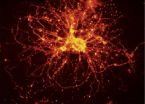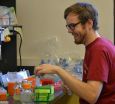(Press-News.org) ANN ARBOR, Mich. — What makes a person bipolar, prone to manic highs and deep, depressed lows? Why does bipolar disorder run so strongly in families, even though no single gene is to blame? And why is it so hard to find new treatments for a condition that affects 200 million people worldwide?
New stem cell research published by scientists from the University of Michigan Medical School, and fueled by the Heinz C. Prechter Bipolar Research Fund, may help scientists find answers to these questions.
The team used skin from people with bipolar disorder to derive the first-ever stem cell lines specific to the condition. In a new paper in Translational Psychiatry, they report how they transformed the stem cells into neurons, similar to those found in the brain – and compared them to cells derived from people without bipolar disorder.
The comparison revealed very specific differences in how these neurons behave and communicate with each other, and identified striking differences in how the neurons respond to lithium, the most common treatment for bipolar disorder.
It's the first time scientists have directly measured differences in brain cell formation and function between people with bipolar disorder and those without.
The researchers are from the Medical School's Department of Cell & Developmental Biology and Department of Psychiatry, and U-M's Depression Center.
Stem cells as a window on bipolar disorder
The team used a type of stem cell called induced pluripotent stem cells, or iPSCs. By taking small samples of skin cells and exposing them to carefully controlled conditions, the team coaxed them to turn into stem cells that held the potential to become any type of cell. With further coaxing, the cells became neurons.
"This gives us a model that we can use to examine how cells behave as they develop into neurons. Already, we see that cells from people with bipolar disorder are different in how often they express certain genes, how they differentiate into neurons, how they communicate, and how they respond to lithium," says Sue O'Shea, Ph.D., the experienced U-M stem cell specialist who co-led the work.
"We're very excited about these findings. But we're only just beginning to understand what we can do with these cells to help answer the many unanswered questions in bipolar disorder's origins and treatment," says Melvin McInnis, M.D., principal investigator of the Prechter Bipolar Research Fund and its programs.
"For instance, we can now envision being able to test new drug candidates in these cells, to screen possible medications proactively instead of having to discover them fortuitously."
The research was supported by donations from the Heinz C. Prechter Bipolar Research Fund, the Steven M. Schwartzberg Memorial Fund, and the Joshua Judson Stern Foundation. The A. Alfred Taubman Medical Research Institute at the U-M Medical School also supported the work, which was reviewed and approved by the U-M Human Pluripotent Stem Cell Research Oversight committee and Institutional Review Board.
O'Shea, a professor in the Department of Cell & Developmental Biology and director of the U-M Pluripotent Stem Cell Research Lab, and McInnis, the Upjohn Woodworth Professor of Bipolar Disorder and Depression in the Department of Psychiatry, are co-senior authors of the new paper.
McInnis, who sees firsthand the impact that bipolar disorder has on patients and the frustration they and their families feel about the lack of treatment options, says the new research could take treatment of bipolar disorder into the era of personalized medicine.
Not only could stem cell research help find new treatments, it may also lead to a way to target treatment to each patient based on their specific profile – and avoid the trial-and-error approach to treatment that leaves many patients with uncontrolled symptoms.
More about the findings:
The skin samples were used to derive the 42 iPSC lines. When the team measured gene expression first in the stem cells, and then re-evaluated the cells once they had become neurons, very specific differences emerged between the cells derived from bipolar disorder patients and those without the condition.
Specifically, the bipolar neurons expressed more genes for membrane receptors and ion channels than non-bipolar cells, particularly those receptors and channels involved in the sending and receiving of calcium signals between cells.
Calcium signals are already known to be crucial to neuron development and function. So, the new findings support the idea that genetic differences expressed early during brain development may have a lot to do with the development of bipolar disorder symptoms – and other mental health conditions that arise later in life, especially in the teen and young adult years.
Meanwhile, the cells' signaling patterns changed in different ways when the researchers introduced lithium, which many bipolar patients take to regulate their moods, but which causes side effects. In general, lithium alters the way calcium signals are sent and received – and the new cell lines will make it possible to study this effect specifically in bipolar disorder-specific cells.
Like misdirected letters and packages at the post office, the neurons made from bipolar disorder patients also differed in how they were 'addressed' during development for delivery to certain areas of the brain. This may have an impact on brain development, too.
The researchers also found differences in microRNA expression in bipolar cells – tiny fragments of RNA that play key roles in the "reading" of genes. This supports the emerging concept that bipolar disorder arises from a combination of genetic vulnerabilities.
The researchers are already developing stem cell lines from other trial participants with bipolar disorder, though it takes months to derive each line and obtain mature neurons that can be studied. They will share their cell lines with other researchers via the Prechter Repository at U-M. They also hope to develop a way to use the cells to screen drugs rapidly, called an assay.
INFORMATION:
Haiming Chen, M.D., and Cindy DeLong, Ph.D., manager of the pluripotent stem cell core laboratory, are co-first authors of the paper.
Reference: Translational Psychiatry, early online publication, March 25, 2014.
First stem cell study of bipolar disorder yields promising results
Stem cell model shows nerve cells develop, behave and respond to lithium differently -- opening doors to potential new treatments
2014-03-25
ELSE PRESS RELEASES FROM THIS DATE:
Fewer children at risk for deficient vitamin D
2014-03-25
MAYWOOD, Il. – Under new guidelines from the Institute of Medicine, the estimated number of children who are at risk for having insufficient or deficient levels of vitamin D is drastically reduced from previous estimates, according to a Loyola University Chicago Stritch School of Medicine study.
The study, led by Holly Kramer, MD, MPH and Ramon Durazo-Arvizu, PhD, is published online ahead of print in the Journal of Pediatric Endocrinology and Metabolism.
New Institute of Medicine guidelines say most people get sufficient vitamin D when their blood levels are at or ...
Black markets for hackers are increasingly sophisticated, specialized and maturing
2014-03-25
Black and gray markets for computer hacking tools, services and byproducts such as stolen credit card numbers continue to expand, creating an increasing threat to businesses, governments and individuals, according to a new RAND Corporation study.
One dramatic example is the December 2013 breach of retail giant Target, in which data from approximately 40 million credit cards and 70 million user accounts was hijacked. Within days, that data appeared -- available for purchase -- on black market websites.
"Hacking used to be an activity that was mainly carried out by individuals ...
Lick's new Automated Planet Finder: First robotic telescope for planet hunters
2014-03-25
Lick Observatory's newest telescope, the Automated Planet Finder (APF), has been operating robotically night after night on Mt. Hamilton since January, searching nearby stars for Earth-sized planets. Every night the fully autonomous system checks the weather, decides which stars to observe, and moves the telescope from star to star throughout the night, collecting measurements that will reveal the presence of planets. Its technical performance has been outstanding, making it not only the first robotic planet-finding facility but also one of the most sensitive.
The search ...
Stink bug traps may increase damage to tomato fruits
2014-03-25
The invasive brown marmorated stink bug (Halyomorpha halys) is an important pest of fruits and vegetables. To counter them, some home gardeners use pheromone-baited traps that are designed to attract, trap, and kill them. However, new research from entomologists at the University of Maryland suggests that the traps may actually increase stink bug damage to tomatoes. The research will appear in the April issue of Environmental Entomology (DOI: http://dx.doi.org/10.1603/EN13237).
The researchers asked 15 gardeners to place stink bug traps at the ends of rows of tomatoes, ...
New method yields potent, renewable human stem cells with promising therapeutic properties
2014-03-25
New Rochelle, NY, March 24, 2014—The curative and therapeutic potential of mesenchymal stem cells (MSCs) offers much promise, as these multipotent cells are currently being tested in more than 300 clinical trials in a range of diseases. A new, easier, and more reliable way to make large quantities of highly potent MSCs could accelerate progress toward their use in regenerative medicine, as described in an article in Stem Cells and Development, a peer-reviewed journal from Mary Ann Liebert, Inc., publishers. The article is available on the Stem Cells and Development website.
Robert ...
The fundamentals of facial recognition
2014-03-25
When it comes to recognizing faces, humans are extraordinarily skillful. It's no surprise – after all, from the moment humans leave the womb, the infant brains already have a preference for faces, and over the course of a lifetime, the average person sees hundreds of thousands of faces.
Among scientists, however, the question of exactly how humans came to possess this amazing ability remains a divisive one, with some researchers claiming our extraordinary abilities result from the operation of mechanisms specialized just for faces, whereas others argue that recognition ...
Study finds gout drug may reduce risk of death
2014-03-25
(Boston)--In a recently to be published study in Annals of the Rheumatic Diseases, researchers have found the use of the drug allopurinol was associated with a reduced risk of death in hyperuricemic (gout) patients. The study, the first in a general population, has found the overall benefit of allopurinol on survival may outweigh the impact of rare serious adverse effects.
Researchers from the Section of Rheumatology and Clinical Epidemiology at Boston University School of Medicine (BUSM) contributed to this study.
Gout has been associated with an increased risk of ...
NOAA led study: Crude oil causes developmental abnormalities in large marine fish
2014-03-25
Crude oil from the 2010 Deepwater Horizon disaster causes severe defects in the developing hearts of bluefin and yellowfin tunas, according to a new study by a team of NOAA and academic scientists.
The findings, published in the Proceedings of the National Academy of Sciences on the 25th anniversary of the Exxon Valdez oil spill, show how the largest marine oil spill in United States history may have affected tunas and other species that spawned in oiled offshore habitats in the northern Gulf of Mexico.
Atlantic bluefin tuna, yellowfin tuna, and other large predatory ...
For neurons in the brain, identity can be used to predict location
2014-03-25
Cold Spring Harbor, NY – Throughout the world, there are many different types of people, and their identity can tell a lot about where they live. The type of job they work, the kind of car they drive, and the foods they eat can all be used to predict the country, the state, or maybe even the city a person lives in.
The brain is no different. There are many types of neurons, defined largely by the patterns of genes they use, and they "live" in numerous distinct brain regions. But researchers do not yet have a comprehensive understanding of these neuronal types and how ...
Scientists find a molecular clue to the complex mystery of auxin signaling in plants
2014-03-25
Wikipedia lists 65 adjectives that botanists use to describe the shapes of plant leaves. In English (rather than Latin) they mean the leaf is lance-shaped, spear-shaped, kidney-shaped, diamond shaped, arrow-head-shaped, egg-shaped, circular, spoon-shaped , heart-shaped, tear-drop-shaped or sickle-shaped — among other possibilities.
How does the plant "know" how to make these shapes? The answer is by controlling the distribution of a plant hormone called auxin, which determines the rate at which plant cells divide and lengthen.
But how can one molecule make so many ...
LAST 30 PRESS RELEASES:
New study finds where you live affects recovery after a hip fracture
Forecasting the impact of fully automated vehicle adoption on US road traffic injuries
Alcohol-related hospitalizations from 2016 to 2022
Semaglutide and hospitalizations in patients with obesity and established cardiovascular disease
Researchers ‘listen in’ to embryo-mother interactions during implantation using a culture system replicating the womb lining
How changing your diet could help save the world
How to make AI truly scalable and reliable for real-time traffic assignment?
Beyond fragmented markets: A new framework for efficient and stable ride-pooling
Can shape priors make road perception more reliable for autonomous driving?
AI tracks nearly 100 years of aging research, revealing key trends and gaps
Innovative techniques enable Italy’s first imaging of individual trapped atoms
KIER successfully develops Korea-made “calibration thermoelectric module” for measuring thermoelectric device performance
Diversifying US Midwest farming for stability and resilience
Emphasizing immigrants’ deservingness shifts attitudes
Japanese eels, climate change, and river temperature
Pusan National University researchers discover faster, smarter heat treatment for lightweight magnesium metals
China’s 2024 Gastroenterology Report: marked progress in endoscopy quality and disease management
Pusan National University researchers uncover scalable method for ultrahigh-resolution quantum dot displays
Researchers use robotics to find potential new antibiotic among hundreds of metal complexes
Gut bacteria changes at the earliest stages of inflammatory bowel disease
Scientists develop new way to “listen in” on the brain’s hidden language
Brain research: “Pulse generators” grow and shrink as memories are formed
For teens, any cannabis use may have impact on emotional health, academic performance
School meals could unlock major gains for human and planetary health
Menopause hormone therapy does not appear to impact dementia risk
Signature patterns of brain activity may help predict recovery from traumatic brain injury
Dresden study uncovers new key mechanism in cancer cells
New species are now being discovered faster than ever before, study suggests
Cannabis-based products show limited short-term benefit for chronic pain, with increased risk of adverse effects
Cannabis products with more THC slightly reduce pain but cause more side effects
[Press-News.org] First stem cell study of bipolar disorder yields promising resultsStem cell model shows nerve cells develop, behave and respond to lithium differently -- opening doors to potential new treatments





